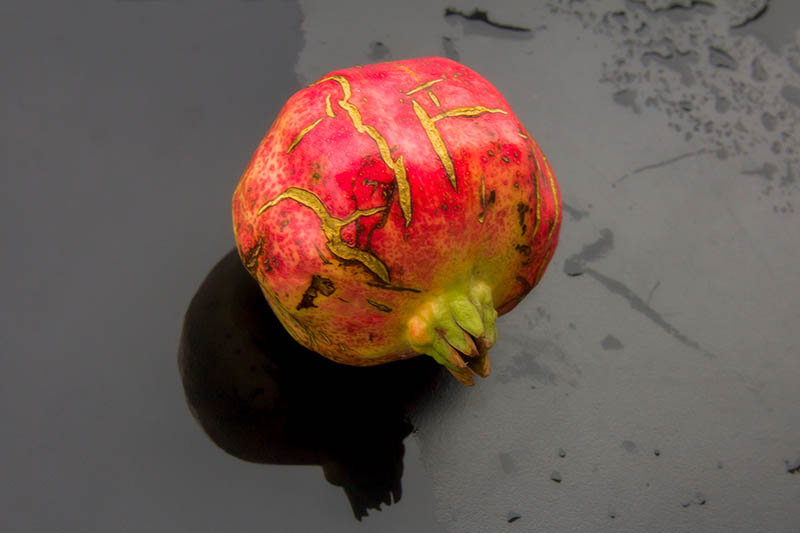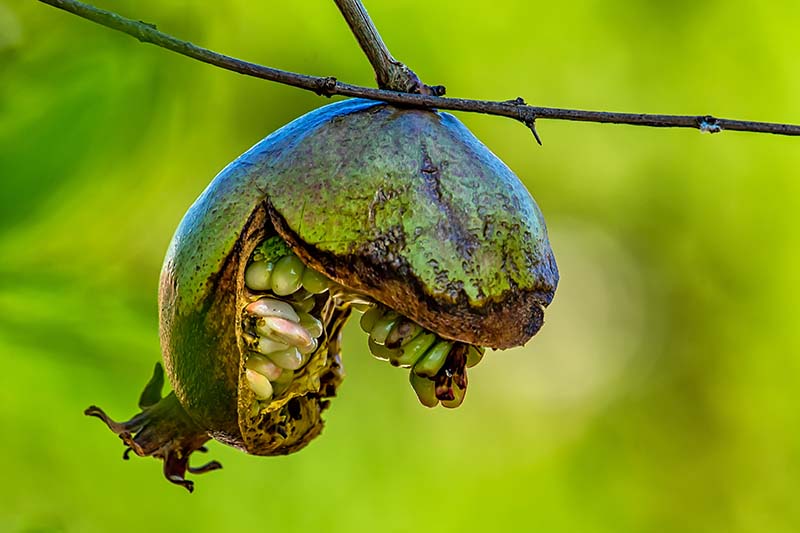When you plant a pomegranate tree, Punica granatum, you’re most likely hoping that it’ll be productive for a long time to come.
It’s necessary to have patience, as it can take a few years before the plants begin to produce fruit.
Each season, you’ll be waiting at least six months from the time they set fruit in spring or summer until they’re ready to harvest, typically in late summer or fall.
While you’re playing the waiting game, there are several factors that not only affect how the fruit matures, but that can impact how successful the yield will ultimately be in terms of quality as well.
We link to vendors to help you find relevant products. If you buy from one of our links, we may earn a commission.
Some of these factors can lead to an unfortunately common outcome: cracked or split fruit. What was once a semi-round, leathery globe is suddenly a mess of exposed, decaying arils, still attached to the limb.

Tips for Protecting Plants from Temperature Fluctuations
Unfortunately, it’s very difficult to prevent cracking due to temperature changes, but making sure your plant is adequately watered can help.
Covering or moving potted plants to provide shade or protection from cold can also help if you are growing a dwarf tree in a container.
All plants have a natural growth cycle, and the goal of this is to propagate more plants, guaranteeing survival of the species.

Pomegranates are no different. If fruits are left to ripen past their prime, they’ll naturally begin to split open, casting seeds onto the soil below, or becoming food for birds and other animals that carry the seeds away to grow in other locations.
Tips for Preventing Water Stress
If you live in a region where rainfall is scarce, it’s best to provide one inch of supplementary water per week, per plant, to keep pomegranates from becoming stressed in times of drought.
It can be easiest to install an irrigation system for watering multiple trees or shrubs, or if you sometimes forget to water your plants. It’s up to you how elaborate of a system you’d prefer to use; they can vary widely in configuration and range in price.
A good basic kit that can be attached to the exterior hose faucet is this one, available from Home Depot.
This system includes drip irrigation tubes and micro-sprinklers which can do the trick to keep plants watered on a budget, or in a smaller area such as a residential yard.
If you’ve got a larger area or more plants to provide water for, you might consider a system that can easily be expanded to cover a larger zone ,and set it to water on a schedule, using a timer to get the job done even if you forget.
But water stress is not the only reason that fruits might crack or split on the tree. Let’s take a look at nutritional issues next.
While pomegranate plants are generally very tolerant of harsh conditions such as drought, high heat, and poor soil, these conditions can sometimes cause stress nonetheless, and lead to growing issues.
Poor soil that is low in organic material or high in clay or sand can lack essential nutrients that support plant growth, as well as bud and fruit development.

Without these nutrients, many signs of distress may become evident, such as stunted growth, discoloration, and bud drop.
Deficiencies can also lead to several issues with developing fruit, particularly in the early stages.
Fruits that do not receive enough potassium or calcium may show signs of chlorosis, or discoloration that presents as “bleaching,” which can preempt cracking and splitting.
Start Eating 1 Pomegranate Every Day, See What Happens to Your Body
FAQ
Can you eat a cracked pomegranate?
Why are my pomegranates cracking?
Is it bad to eat the hard part of pomegranate seeds?
Can you eat the crunchy pomegranate seeds?
Are cracked pomegranates salvageable?
Cracked pomegranates may be salvageable if the interior pith is not breached, and the arils remain protected and moist. Even those that split open widely could still be usable if you’re able to catch them early on.
How to eat pomegranate?
The pomegranate can be consumed fresh directly or you can make juice and take it alone or mix it with other fruits. It can also be consumed in other preparations such as jams, desserts, and cakes.
Do pomegranates crack in the fall?
Overwatering in the fall in particular, when the majority of the fruit is ripening, will likely lead to cracking. If you live in a region where rainfall is scarce, it’s best to provide one inch of supplementary water per week, per plant, to keep pomegranates from becoming stressed in times of drought.
Should you buy a pomegranate if it’s not ripe?
The sweet, tart and juicy arils of a pomegranate are a real treat—but when you buy the whole fruit, you do have to put in a fair bit of effort to extract these health-boosting and palate-pleasing little gems. Which is why it’s so upsetting to go through all that hard work only to be rewarded with an unripe piece of fruit.
